
The herons are long-legged, long-necked, freshwater and coastal birds in the family Ardeidae, with 72 recognised species, some of which are referred to as egrets or bitterns rather than herons. Members of the genera Botaurus and Ixobrychus are referred to as bitterns, and, together with the zigzag heron, or zigzag bittern, in the monotypic genus Zebrilus, form a monophyletic group within the Ardeidae. Egrets do not form a biologically distinct group from herons, and tend to be named differently because they are mainly white or have decorative plumes in breeding plumage. Herons, by evolutionary adaptation, have long beaks.

The yellow-crowned night heron, is one of two species of night heron in genus Nyctanassa. Unlike the black-crowned night heron, which has a worldwide distribution, the yellow-crowned is restricted to the Americas. It is known as the bihoreau violacé in French and the pedrete corona clara in Spanish.

A towhee is any one of a number of species of birds in the genus Pipilo or Melozone within the family Passerellidae.

The Bermuda skink, longnose skink, or Bermuda rock lizard is a critically endangered species and the only endemic land-living vertebrate of Bermuda. It is a relatively small skink : adults reach an average snout-to-vent length of about 8 cm (3.1 in).
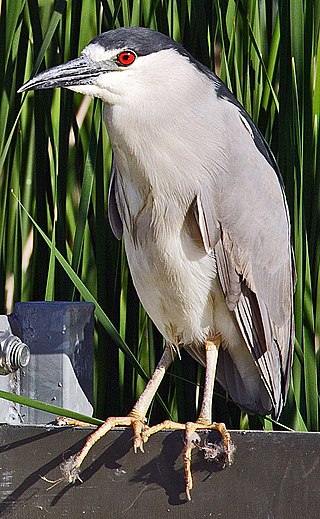
Nycticorax is a genus of night herons. The name Nycticorax means "night raven" and derives from the Ancient Greek νύκτος, nuktos "night" and κοραξ, korax, "raven". It refers to the largely nocturnal feeding habits of this group of birds, and the croaking crow-like call of the best known species, the black-crowned night heron.

The night herons are medium-sized herons, 58–65 cm, in the genera Nycticorax, Nyctanassa, and Gorsachius. The genus name Nycticorax derives from the Greek for "night raven" and refers to the largely nocturnal feeding habits of this group of birds, and the croaking crow-like, almost like a barking sound, call of the best known species, the black-crowned night heron.
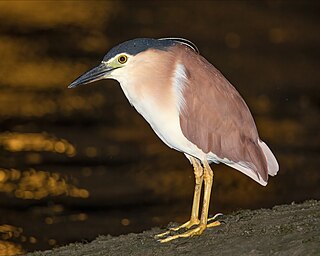
The nankeen night heron is a heron that belongs to the genus Nycticorax and the family Ardeidae. Due to its distinctive reddish-brown colour, it is also commonly referred to as the rufous night heron. It is primarily nocturnal and is observed in a broad range of habitats, including forests, meadows, shores, reefs, marshes, grasslands, and swamps. The species is 55 to 65 cm in length, with rich cinnamon upperparts and white underparts. The nankeen night heron has a stable population size, and is classified as a species of least concern by the International Union for Conservation of Nature (IUCN).
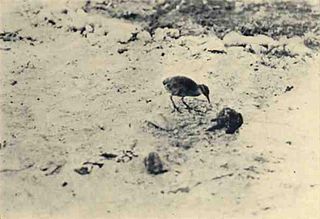
The extinct Wake Island rail was a flightless rail and the only native land bird on the Pacific atoll of Wake. It was found on the islands of Wake and Wilkes, but not on Peale, which is separated from the others by a channel of about 100 meters. It was hunted to extinction during World War II.
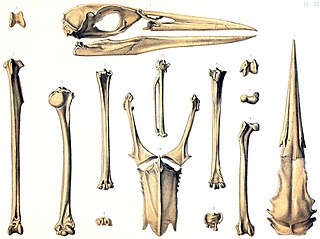
The Rodrigues night heron is an extinct species of heron that was endemic to the Mascarene island of Rodrigues in the Indian Ocean. The species was first mentioned as "bitterns" in two accounts from 1691–1693 and 1725–1726, and these were correlated with subfossil remains found and described in the latter part of the 19th century. The bones showed that the bird was a heron, first named Ardea megacephala in 1873, but moved to the night heron genus Nycticorax in 1879 after more remains were described. The specific name megacephala is Greek for "great-headed". Two related extinct species from the other Mascarene islands have also been identified from accounts and remains: the Mauritius night heron and the Réunion night heron.
Lake Miragoâne is a lake in Haiti, located one kilometer southeast of the city of Miragoâne. It is one of the largest natural freshwater lakes in the Caribbean. The lake is 12 km (7.5 mi) long and 25 km² (9.7 mi²) in area.
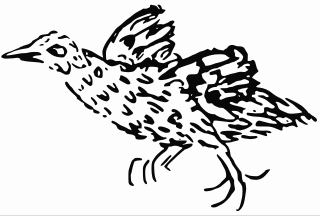
The Ascension crake is an extinct flightless bird that previously lived on Ascension Island in the South Atlantic Ocean. Like many other flightless birds on isolated islands, it was a rail. It was declared extinct by Groombridge in 1994; BirdLife International confirmed this in 2000 and 2004.
Sipacate-Naranjo National Park is located along the Pacific coast of Escuintla in Guatemala. The park includes mangrove forests, lagoons and sandy beaches and covers an area of 20 km long and 1 km wide, stretching between the coastal towns of Sipacate and El Naranjo.
Ascocotyle pindoramensis is a fluke in the genus Ascocotyle that occurs along the eastern coast of the Americas from Brazil to Nicaragua, Mexico, Louisiana, and Florida and doubtfully in Egypt. It occurs in the intestine of its definitive hosts. Hosts recorded in the wild include the least bittern, roseate spoonbill, great blue heron, striated heron, stripe-backed bittern, yellow-crowned night heron, black-crowned night heron, osprey, Neotropic cormorant, and marsh rice rat. In the marsh rice rat, it infected 9% of rats examined in a 1970–1972 study in the salt marsh at Cedar Key, Florida, but none in a freshwater marsh. A. pindoramensis has been experimentally introduced into the domestic duck, chicken, dog, house mouse, and golden hamster. It occurs in various body parts of its intermediate hosts—the poeciliid fish Phalloptychus januarius, Poecilia catemaconis, Poecilia mexicana, Poecilia mollienisicola, Poecilia vivipara, and a species of Xiphophorus and the cichlid Tilapia. It was first described as Pygidiopsis pindoramensis in 1928 and subsequently as Pseudoascocotyle mollienisicola in 1960. The latter species was moved to Ascocotyle in 1963, but only in 2006 it was recognized that the two represent the same species, which is now known as Ascocotyle pindoramensis. Other flukes from Argentina and Mexico that were identified as Pygidiopsis pindoramensis instead represent a different species of Pygidiopsis.
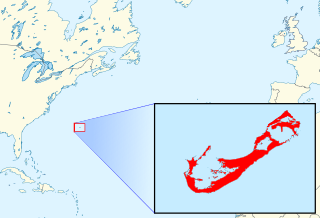
The Bermuda towhee is an extinct bird of the towhee genus Pipilo that was endemic to Bermuda.
Hungry Bay Nature Reserve is a nature reserve on the east coast of Bermuda. It was established in 1986. It is considered the best example of coastal mangrove swamp on the island. It includes the Hungry Bay area and the largest mangrove coastal swamp in Bermuda. It is protected by a Tree preservation order (T.P.O.) and designated as an official Nature Reserve within the Parks system of Bermuda.
The Bermuda flicker is an extinct woodpecker from the genus Colaptes. It was confined to Bermuda and is known only by fossil remains dated to the Late Pleistocene and the Holocene. However, an old travel report by explorer Captain John Smith from the 17th century may also refer to this species.
Strongyloides ardeae is a parasitic roundworm infecting the small intestine of yellow-crowned night heron, Nyctanassa violacea, and eastern green heron, Butorides virescens. It was first described from Louisiana.

The Southern Dry Pacific Coast mangroves ecoregion covers a series of mangrove forests along the Pacific Ocean coast of Nicaragua and Costa Rica, from the southern margin of the Gulf of Fonseca to the Gulf of Nicoya near the border with Panama. Because the area is drier than the mangroves further south, evapotranspiration leaves some areas with higher salinity and even salt pans in the internal areas.












